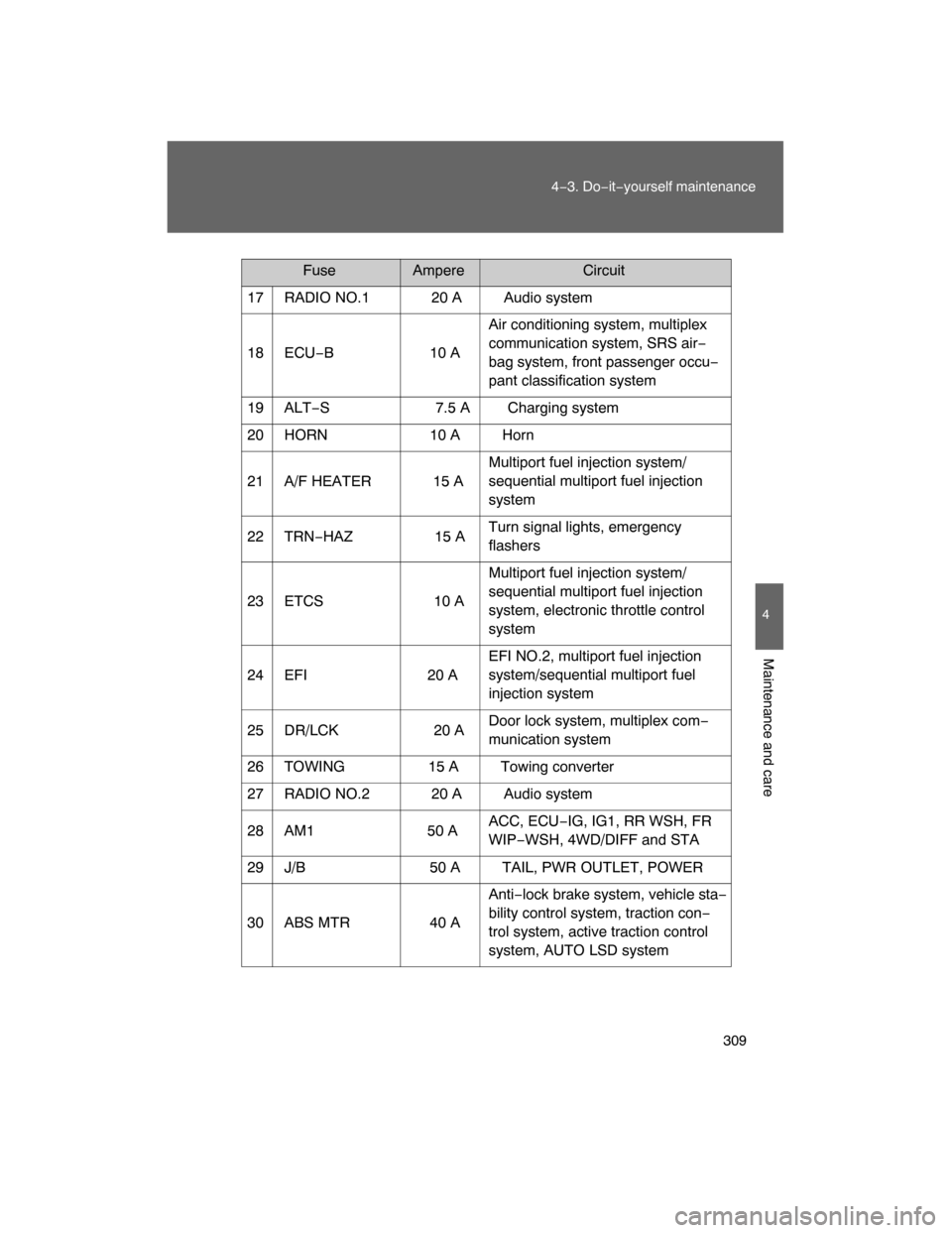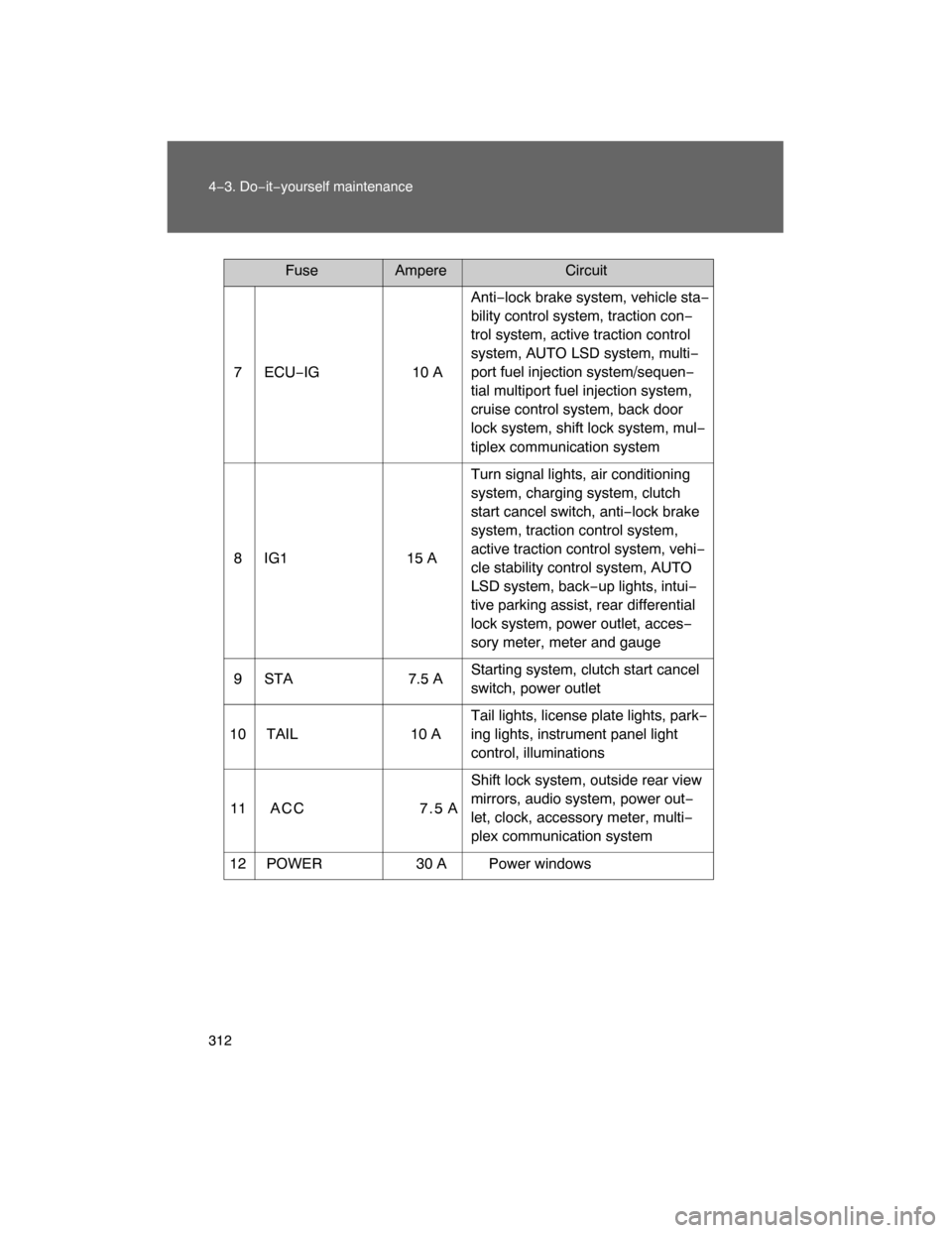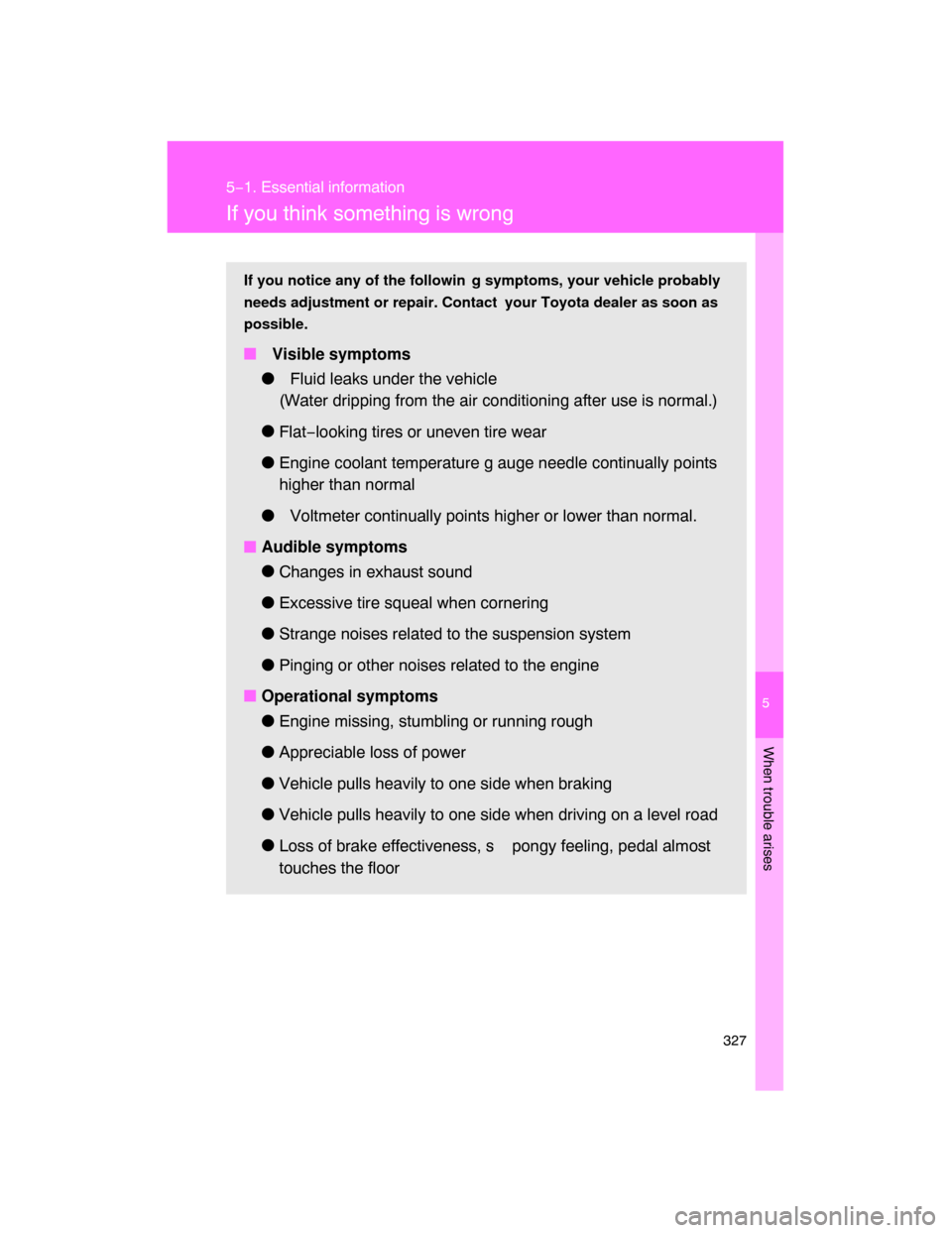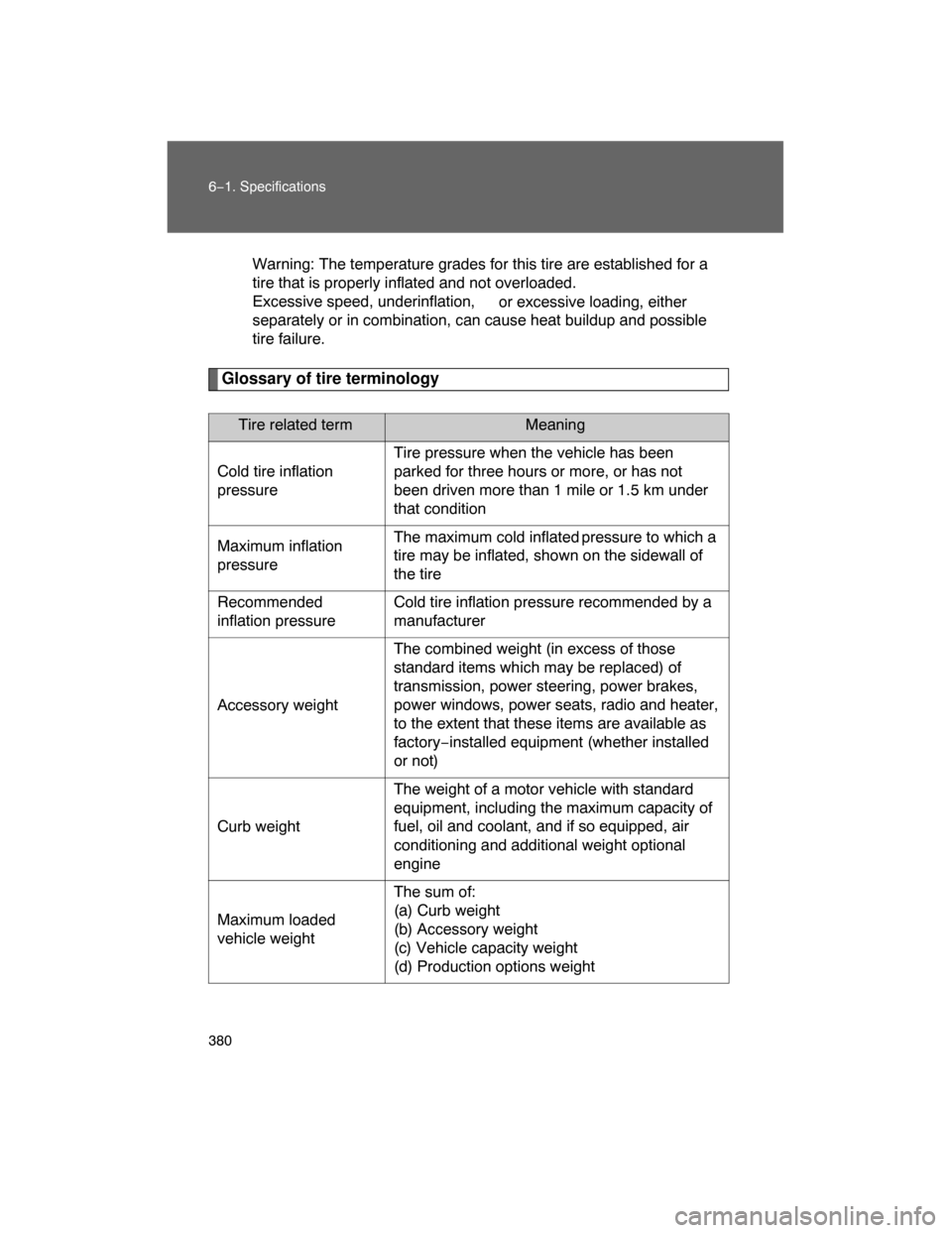Page 295 of 400
299
4−3. Do−it−yourself maintenance
4
Maintenance and care
Remove the filter case.
� Cleaning method
If the filter is dirty, clean by
blowing compressed air
through the filter from the
downward side.
Hold the air gun 2 in. (5 cm)
from the filter and blow for
approximately 2 minutes at
72 psi (500 kPa, 5.0 kgf/cm
2
or bar).
If it is not available, have
the filter cleaned by your
Toyota dealer.
� Replacement method
Remove the air conditioning
filter and replace it with a new
one.
The “UP” marks shown on the
filter should be pointing up.
Page 296 of 400
300 4−3. Do−it−yourself maintenance
� Checking interval
Inspect, clean and replace the air conditioning filter according to the mainte−
nance schedule. In dusty areas or areas with heavy traffic flow, more fre−
quent cleaning or early replacement may be required. (For scheduled
maintenance information, please refer to the “Scheduled Maintenance
Guide” or “Owner ’s Manual Supplement”.)
� If air flow from the vents decreases dramatically
The filter may be clogged. Check the filter and replace if necessary.
NOTICE
� To prevent damage to the system
� When using the air conditioning system, make sure that a filter is always
installed.
�
When cleaning the filter, do not clean the filter with water.
Page 305 of 400

309
4−3. Do−it−yourself maintenance
4
Maintenance and care
17 RADIO NO.1 20 A Audio system
18 ECU−B 10 AAir conditioning system, multiplex
communication system, SRS air−
bag system, front passenger occu−
pant classification system
19 ALT−S 7.5 A Charging system
20 HORN 10 A Horn
21 A/F HEATER 15 AMultiport fuel injection system/
sequential multiport fuel injection
system
22 TRN−HAZ 15 ATurn signal lights, emergency
flashers
23 ETCS 10 AMultiport fuel injection system/
sequential multiport fuel injection
system, electronic throttle control
system
24 EFI 20 AEFI NO.2, multiport fuel injection
system/sequential multiport fuel
injection system
25 DR/LCK 20 ADoor lock system, multiplex com−
munication system
26 TOWING 15 A Towing converter
27 RADIO NO.2 20 A Audio system
28 AM1 50 AACC, ECU−IG, IG1, RR WSH, FR
WIP−WSH, 4WD/DIFF and STA
29 J/B 50 A TAIL, PWR OUTLET, POWER
30 ABS MTR 40 A
Anti−lock brake system, vehicle sta−
bility control system, traction con−
trol system, active traction control
system, AUTO LSD system
FuseAmpereCircuit
Page 306 of 400
310 4−3. Do−it−yourself maintenance
*1: Vehicles with daytime running light
*2: Vehicles without daytime running light31 AM2 30 AIGN and GAUGE, multiport fuel
injection system/sequential multi−
port fuel injection system, starting
system
32 ABS SOL 30 AAnti−lock brake system, vehicle sta−
bility control system, traction con−
trol system, active traction control
system, AUTO LSD system
33 ALT 120 AAM1, AC 115V, DEFOG, DEFOG
NO.2, STOP, OBD, J/B, TOWING
TAIL, AUX LP and OFFROAD LP
34 HEATER 60 A Air conditioning system
35 AC 115V 80 A Power outlet
FuseAmpereCircuit
Page 308 of 400

312 4−3. Do−it−yourself maintenance
7 ECU−IG 10 AAnti−lock brake system, vehicle sta−
bility control system, traction con−
trol system, active traction control
system, AUTO LSD system, multi−
port fuel injection system/sequen−
tial multiport fuel injection system,
cruise control system, back door
lock system, shift lock system, mul−
tiplex communication system
8 IG1 15 ATurn signal lights, air conditioning
system, charging system, clutch
start cancel switch, anti−lock brake
system, traction control system,
active traction control system, vehi−
cle stability control system, AUTO
LSD system, back−up lights, intui−
tive parking assist, rear differential
lock system, power outlet, acces−
sory meter, meter and gauge
9 STA 7.5 AStarting system, clutch start cancel
switch, power outlet
10 TAIL 10 ATail lights, license plate lights, park−
ing lights, instrument panel light
control, illuminations
11 A C C 7 . 5 AShift lock system, outside rear view
mirrors, audio system, power out−
let, clock, accessory meter, multi−
plex communication system
12 POWER 30 A Power windows
FuseAmpereCircuit
Page 322 of 400

5
When trouble arises
327
5−1. Essential information
If you think something is wrong
If you notice any of the followin g symptoms, your vehicle probably
needs adjustment or repair. Contact your Toyota dealer as soon as
possible.
� Visible symptoms
� Fluid leaks under the vehicle
(Water dripping from the air conditioning after use is normal.)
�
Flat−looking tires or uneven tire wear
�Engine coolant temperature g auge needle continually points
higher than normal
� Voltmeter continually points higher or lower than normal.
�Audible symptoms
�
Changes in exhaust sound
�
Excessive tire squeal when cornering
�Strange noises related to the suspension system
�
Pinging or other noises related to the engine
�
Operational symptoms
�Engine missing, stumbling or running rough
�
Appreciable loss of power
�
Vehicle pulls heavily to one side when braking
�Vehicle pulls heavily to one side when driving on a level road
�
Loss of brake effectiveness, s pongy feeling, pedal almost
touches the floor
Page 352 of 400
5
When trouble arises
357 5−2. Steps to take in an emergency
The engine has cooled down sufficiently.
The engine coolant temperature gauge indicates C.
Check the engine coolant level.
Look for obvious coolant leaks
from the radiator, hoses and
under the vehicle.
Note that water draining from the air conditioning is normal if it has
been used.
Add engine coolant if required.
Water can be used in an emer−
gency if engine coolant is
unavailable. (
P. 366)
Have the vehicle checked at your nearest Toyota dealer as soon as
possible.
Page 374 of 400

380 6−1. Specifications
Warning: The temperature grades for this tire are established for a
tire that is properly inflated and not overloaded.
Excessive speed, underinflation,
or excessive loading, either
separately or in combination, can cause heat buildup and possible
tire failure.
Glossary of tire terminology
Tire related term Meaning
Cold tire inflation
pressureTire pressure when the vehicle has been
parked for three hours or more, or has not
been driven more than 1 mile or 1.5 km under
that condition
Maximum inflation
pressureThe maximum cold inflated pressure to which a
tire may be inflated, shown on the sidewall of
the tire
Recommended
inflation pressureCold tire inflation pressure recommended by a
manufacturer
Accessory weightThe combined weight (in excess of those
standard items which may be replaced) of
transmission, power steering, power brakes,
power windows, power seats, radio and heater,
to the extent that these items are available as
factory−installed equipment (whether installed
or not)
Curb weightThe weight of a motor vehicle with standard
equipment, including the maximum capacity of
fuel, oil and coolant, and if so equipped, air
conditioning and additional weight optional
engine
Maximum loaded
vehicle weight
The sum of:
(a) Curb weight
(b) Accessory weight
(c) Vehicle capacity weight
(d) Production options weight